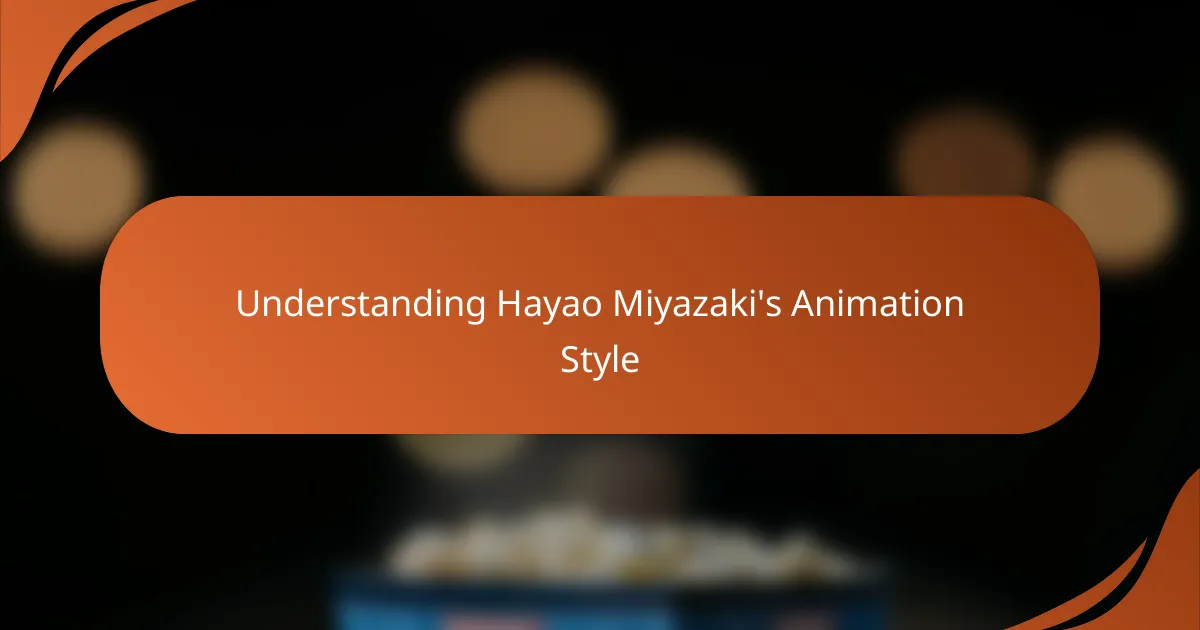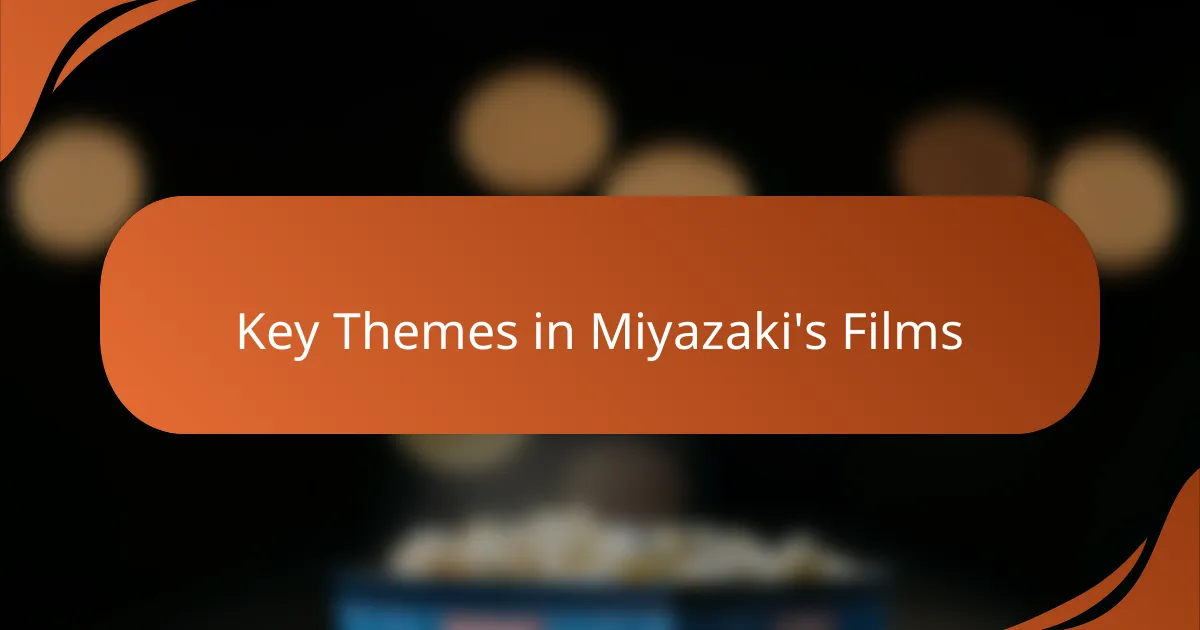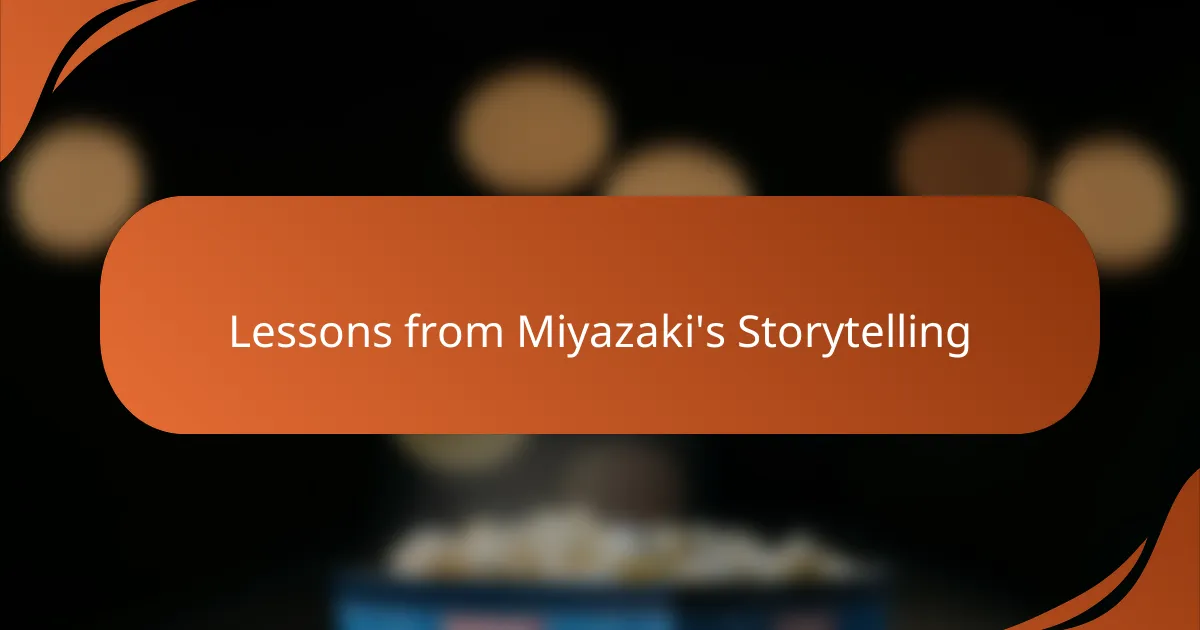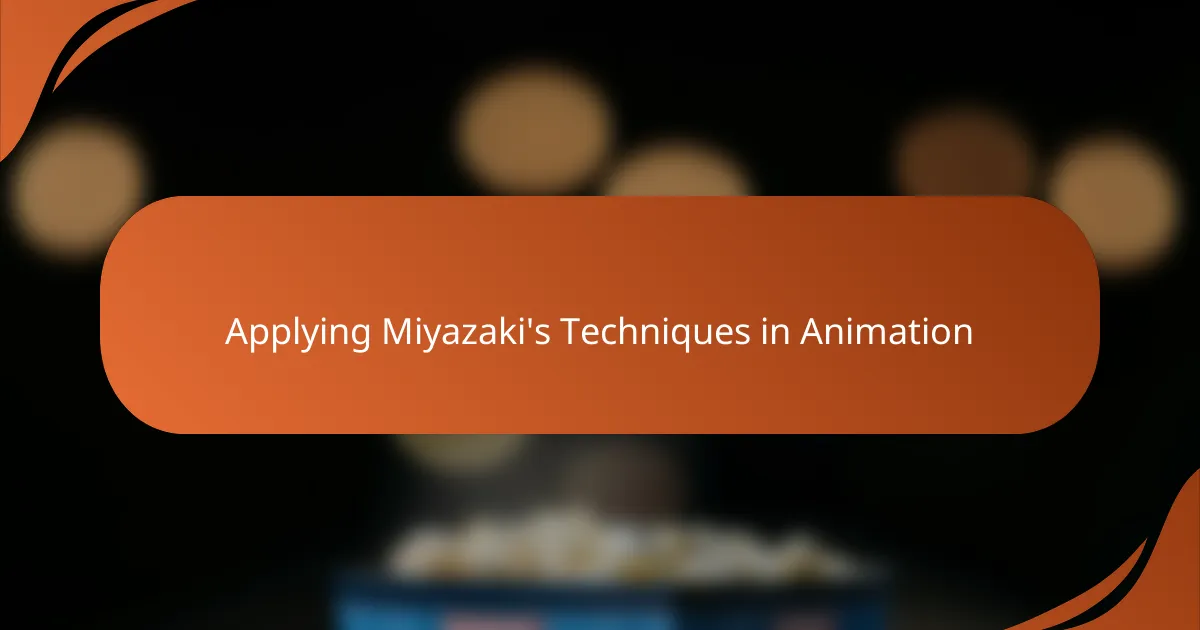Key takeaways
- Miyazaki’s animation blends detailed hand-drawn lines with emotional depth, creating lifelike environments and characters.
- Thematic focuses include reverence for nature, complex female protagonists, and a critique of modernity versus traditional life.
- His storytelling emphasizes subtlety, patience, and the exploration of complex emotions, inviting viewers to engage deeply with the narrative.
- Miyazaki elevates animation as an art form that fosters empathy, understanding, and a heightened appreciation for everyday beauty.

Understanding Hayao Miyazaki’s Animation Style
When I first watched a Hayao Miyazaki film, I was immediately struck by the fluidity and warmth of his animation. His style is so distinct because it blends delicate hand-drawn lines with intricate details that bring each frame to life. Have you ever noticed how the environments almost breathe with a life of their own, as if the wind and trees are characters themselves?
What fascinates me is Miyazaki’s ability to infuse emotion into even the smallest movements—like the flutter of eyelashes or the subtle sway of clothing. This subtlety creates a deep connection with the characters, making their experiences feel genuine and heartfelt. It’s not just animation; it’s storytelling through every brushstroke.
Miyazaki’s animation style also reflects a profound respect for nature and the fantastical. His worlds are richly textured, combining the real and the surreal in a way that invites you to believe in magic without ever feeling disconnected from reality. Have you ever wondered how animation can evoke such nostalgia and wonder all at once? For me, it’s Miyazaki’s masterful hand that achieves this balance.

Key Themes in Miyazaki’s Films
One of the most compelling themes I’ve noticed in Miyazaki’s films is his deep reverence for nature. It’s not just a backdrop but almost a living entity that interacts with the characters, teaching us to appreciate the delicate balance of the world around us. I remember watching My Neighbor Totoro and feeling such a pure sense of wonder at how the forest seemed alive—doesn’t that make you want to step outside and notice those quiet moments in nature more?
Another theme that always hits me is the portrayal of strong, complex female protagonists. Unlike many mainstream films, Miyazaki’s heroines are courageous without being perfect—they’re relatable and flawed, yet fiercely determined. This refreshes my perspective on storytelling, showing that true strength often lies in vulnerability and resilience.
Miyazaki also weaves in a subtle but powerful critique of modernity and industrialization. His films often contrast the harshness of technological progress with the simplicity and [censured] of traditional life. It makes me pause to think about how we define progress and what we might be losing in the process—do we truly need to sacrifice nature for convenience? These themes resonate deeply, reminding me why his stories feel timeless.

How BBC UK Reviews Highlight Miyazaki’s Work
What stands out to me in BBC UK reviews is their appreciation for the delicate balance Miyazaki strikes between breathtaking visuals and profound storytelling. They often highlight how his animation isn’t just eye candy but a vital part of the narrative, deepening the emotional impact. Have you noticed how these reviews pick up on the subtle nuances that make his films linger long after the credits roll?
The reviews don’t shy away from praising Miyazaki’s unique ability to create worlds that feel both magical and grounded in reality. I find it refreshing how BBC critics emphasize the authenticity in his fantasy realms, celebrating the way they invite viewers to explore big themes through seemingly simple stories. It makes me think—how often do we get films that handle such complexity with such gentle artistry?
BBC UK also draws attention to the universal appeal of Miyazaki’s characters, particularly his resilience and humanity. Reading those reviews, I felt a kinship with their admiration for his flawed yet inspiring protagonists. Doesn’t it feel like they remind us that animation can be seriously profound, challenging the notion that it’s just for children? That perspective truly deepened my appreciation.

Personal Impact of Miyazaki’s Animation
Miyazaki’s animation has a way of touching something deep inside me that few other films do. I still remember the first time I watched Spirited Away—the way the spirits moved and the world unfolded felt almost like stepping into a dream I never wanted to leave. Have you ever had a film that feels less like watching and more like experiencing?
There’s an emotional honesty in his work that resonates with my own sense of wonder and curiosity. When characters show vulnerability or joy through subtle gestures, it reminds me of the quiet, powerful moments in life that often go unnoticed. It made me realize how much animation can capture the complexity of human feeling without saying a word.
Miyazaki’s stories have also influenced how I see the world around me. Watching his films encourages me to appreciate everyday beauty—the rustling of leaves, the pattern of clouds—as if they hold a secret magic. Isn’t it remarkable how something as simple as animation can inspire you to slow down and truly see?

Lessons from Miyazaki’s Storytelling
What I find most striking about Miyazaki’s storytelling is how he trusts the viewer’s intelligence, weaving complex emotions and moral ambiguity into narratives that still feel accessible. Have you noticed how his stories don’t spell everything out, instead inviting you to fill in the spaces? This subtlety makes each viewing a richer experience, uncovering new layers every time.
Another lesson I’ve taken from his work is the power of pacing and patience. Miyazaki’s tales often unfold slowly, allowing moments of quiet reflection that many modern films skip over. It’s in these pauses that I feel the story breathes and the characters truly come alive—something I now appreciate more deeply in all storytelling.
Finally, Miyazaki’s use of resilience and hope amidst adversity teaches us that stories don’t have to be bleak to be honest. His characters face real struggles but are imbued with a gentle optimism that never feels forced. Watching this reminded me how storytelling can heal and inspire, even while confronting difficult truths. Have you felt that kind of emotional balance in a film before? For me, it’s one of Miyazaki’s greatest gifts.

Applying Miyazaki’s Techniques in Animation
When I first tried applying Miyazaki’s techniques in my own animation work, I realized the importance of capturing subtle movements—like the gentle sway of leaves or a character’s fleeting glance. It’s those little details that transform a scene from static to alive, creating an emotional resonance that’s hard to achieve otherwise. Have you ever noticed how such small gestures can say more than words ever could?
One technique I admire and often try to emulate is his layering of backgrounds with rich textures and natural elements. Instead of making settings just a backdrop, Miyazaki treats the environment as an active participant in the story. This approach encourages animators to think beyond characters and plot, inviting us to build worlds that hold meaning themselves.
What’s challenging but rewarding about using Miyazaki’s style is balancing realism with fantasy without losing authenticity. His animation feels magical, yes, but also rooted in observation and respect for the real world. When I keep that balance in mind, I find my own work gains a depth that feels more sincere and captivating. Have you tried blending reality and imagination in your projects this way? It’s a game-changer.

Why I Value Miyazaki’s Contributions
What I truly value about Miyazaki’s contributions is how he elevates animation into an art form that speaks directly to the heart. His ability to create stories that are both deeply personal and universally resonant makes his work feel timeless to me—almost like he’s inviting us into a shared dream. Have you ever watched one of his films and felt that unexpected emotional tug, as if you’ve just rediscovered a part of your own imagination? That’s the magic he brings.
Another reason Miyazaki’s work stands out is his fearless commitment to crafting complex characters and themes that challenge conventional norms. I appreciate how he never underestimates his audience, weaving in ethical dilemmas and emotional depth that stay with me long after I’ve stopped watching. It makes me reflect on how animation can be so much more than entertainment—it can be a powerful vehicle for empathy and understanding.
Finally, I can’t separate my appreciation from the way Miyazaki’s artistry inspires me personally. His films remind me to slow down and notice the little things—the rustle of leaves, the quiet moments between dialogue—that often go unnoticed. Isn’t it incredible how his attention to detail encourages us to see the world through a more attentive eye? For me, that’s one of the greatest contributions he’s given not just to animation, but to how we experience storytelling itself.